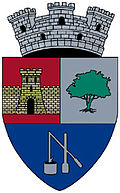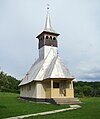Șomcuta Mare
|
Şomcuta Mare Great Horn Nagysomkút |
||||
|
||||
| Basic data | ||||
|---|---|---|---|---|
| State : |
|
|||
| Historical region : | Sathmar | |||
| Circle : | Maramureș | |||
| Coordinates : | 47 ° 30 ' N , 23 ° 28' E | |||
| Time zone : | EET ( UTC +2) | |||
| Height : | 220 m | |||
| Area : | 120.40 km² | |||
| Residents : | 7,565 (October 20, 2011) | |||
| Population density : | 63 inhabitants per km² | |||
| Postal code : | 437335 | |||
| Telephone code : | (+40) 02 62 | |||
| License plate : | MM | |||
| Structure and administration (as of 2016) | ||||
| Community type : | city | |||
| Structure : | 7 districts / cadastral communities: Buciumi , Buteasa , Ciolt , Codru Butesii , Finteușu Mare , Hovrila , Vălenii Șomcutei | |||
| Mayor : | Gheorghe Ioan Buda ( PSD ) | |||
| Postal address : | St. Republicii, no. 7 loc. Șomcuta Mare, jud. Maramureș, RO-437335 |
|||
| Website : | ||||
| Others | ||||
| City Festival : | June | |||
Șomcuta Mare [ ʃomˈkuta mare ] ( German Großhorn , Hungarian Nagysomkút ) is a small town in the Maramureş district in Romania .
location
Șomcuta Mare is located in the Sathmar region in the valley of the Bârsau River , a right tributary of the Someş . The district capital Baia Mare is about 20 km north.
history
In 1358 the place - which then belonged to the Kingdom of Hungary - was first mentioned. He initially belonged to the rule of the castle Kővár (Romanian Chioar ) in Berkeszpataka (Romanian Berchezoaia ). In 1566 the rule of Kővár was divided; Șomcuta Mare became a suburb of an aristocratic rule, which included 14 villages. At the end of the 17th century, the place came to Austria-Hungary . The importance of Șomcuta Mare grew after the destruction of the Kővár castle in 1718 as a result of the Kuruzenkwar . A Romanian school is said to have been founded as early as 1784. Weekly markets were allowed to be held at the end of the 19th century; some banks opened. Șomcuta Mare became the seat of a chair district in the Hungarian county of Sathmar . After the end of the First World War , the place came to Romania; industrial companies settled here on a modest scale.
In 2004 Șomcuta Mare was declared a city. Today agriculture, forestry and marble processing are the most important branches of the economy.
population
In 1850, 4420 people lived in the area of today's town, 941 of them in Șomcuta Mare and 3479 in the towns that are now incorporated. 4103 of these identified themselves as Romanians, 180 as Jews , 80 as Roma and 57 as Hungarians . In 1920 the proportion of Jews was about 13%. In 1977 the maximum population was found at 8502. In the 2002 census, 7708 inhabitants were registered, of which 3693 in Șomcuta Mare and 4015 in the incorporated villages. 6810 were Romanians, 722 Roma and 167 Hungarians.
traffic
Nowadays Șomcuta Mare no longer has a railway connection. The narrow-gauge railway towards Ardusat was discontinued at the beginning of the 1970s. There are regular bus connections to Baia Mare.
Attractions
- Roman Catholic Church (1896). Altarpiece by Miklós Barabás .
- Wooden churches in the districts of Vălenii Șomcutei (17th century), Buteasa (1800) and Codru Butesii (19th century)
- Park (mid 19th century)
- Pădurea Fersig nature reserve
- Cave at Vălenii Șomcutei
Web links
Individual evidence
- ↑ 2011 census in Romania at citypopulation.de
- ^ Website of the city, accessed on February 23, 2009 ( Memento of March 24, 2009 in the Internet Archive )
- ↑ 2002 census, accessed on February 23, 2009 (PDF; 666 kB)
- ↑ Rail Forum Railnet.ro





